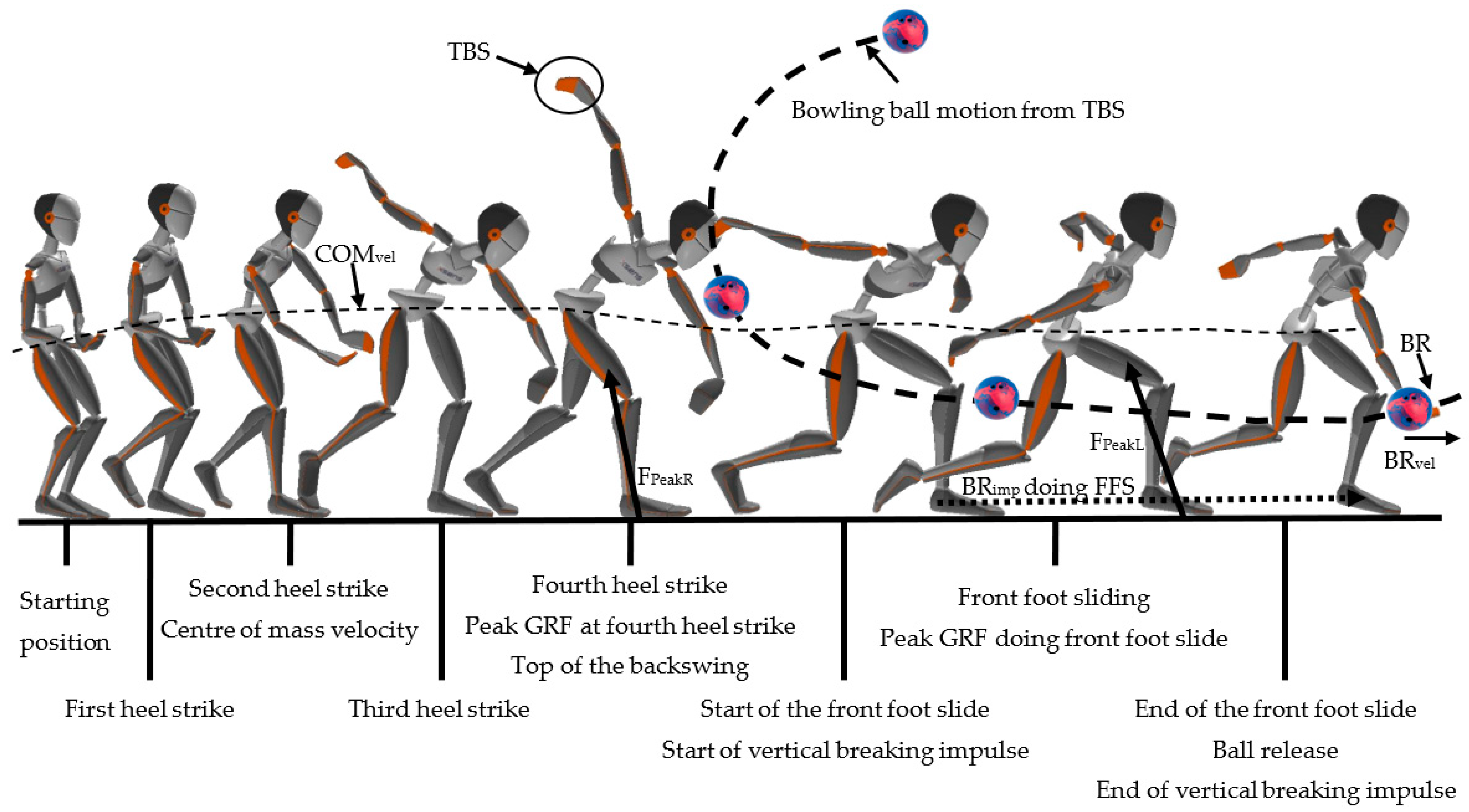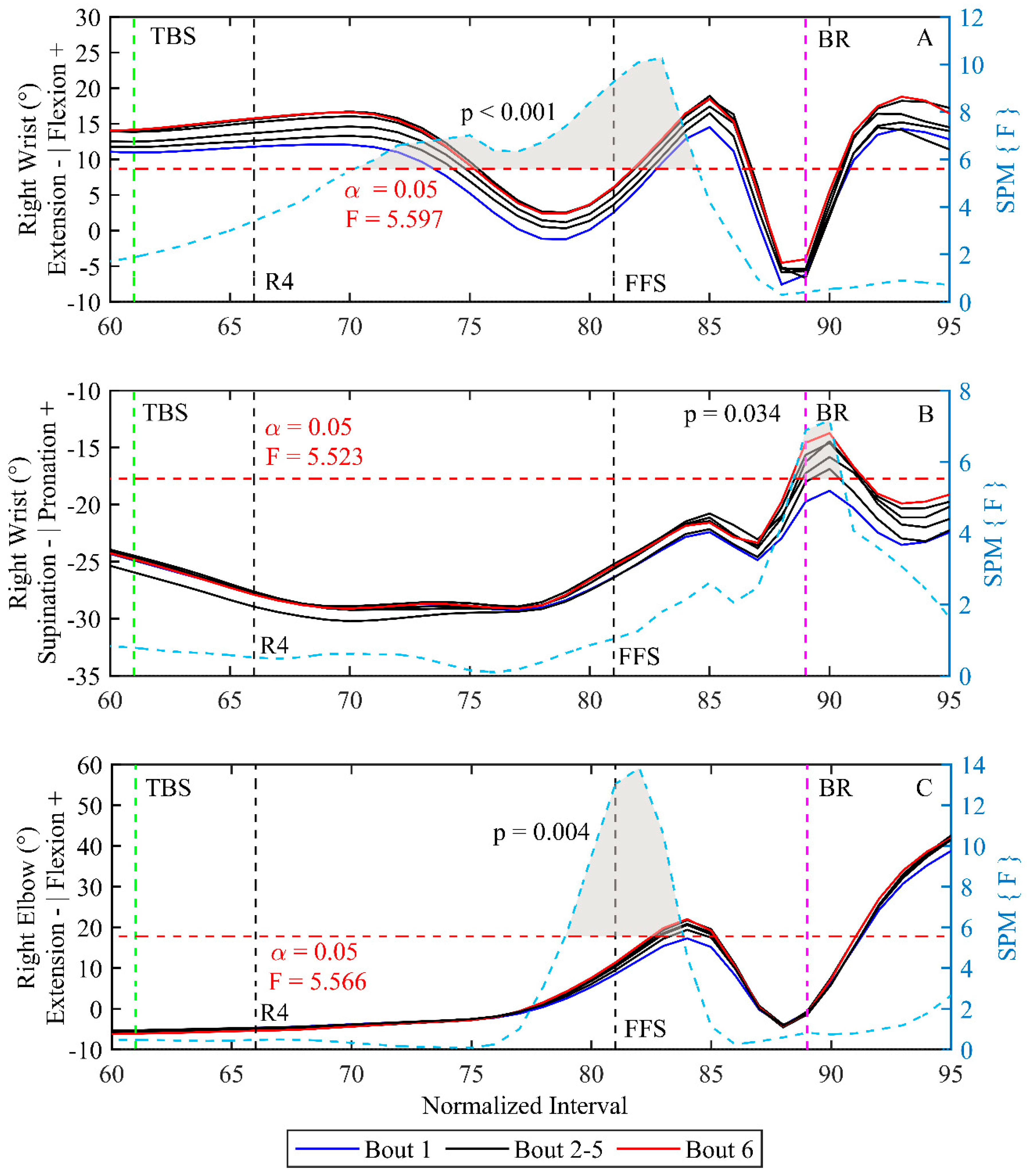Full-Body Kinematics and Vertical Ground Reaction Forces in Elite Ten-Pin Bowling: A Field Study
Abstract
:1. Introduction
2. Materials and Methods
2.1. Participants
2.2. Experimental Protocol
2.3. Data Recording
2.4. Data Analysis
2.4.1. Bowling Parameters
2.4.2. Joint Angles
2.5. Statistical Analysis
3. Results
3.1. Bowling Parameters
3.2. Correlation Matrix
3.3. Joint Kinematics
4. Discussion
5. Conclusions
Author Contributions
Funding
Institutional Review Board Statement
Informed Consent Statement
Data Availability Statement
Acknowledgments
Conflicts of Interest
Abbreviations
| BRvel | Bowling ball release velocity |
| BR | Bowling ball release |
| TBS | Top of the backswing (highest bowling ball position) |
| FFS | Front foot slide (bowler slides, breaks before a foul line and releases the bowling ball) |
| COMvel | Centre of mass velocity |
| BRimp | Vertical breaking impulses (From start of FFS until BR) |
| IMU | Inertial measurement units |
| GRF | Ground reaction force |
| SD | Standard deviation |
| Bscore | Bowling score (measured as pins (0–10)) |
| FpeakL | Peak GRF generated doing the FFS |
| FpeakR | Peak GRF generated doing the last heel contact before FFS |
| SPM1D | One dimensional statistical parametric mapping |
References
- Chu, D.P.K.; Zhang, B.; Mau, K. Tenpin bowling technique on elite players. In Proceedings of the 20 International Symposium on Biomechanics in Sports (2002), ISBS-Conference Proceedings Archive, Cáceres, Spain, 1–5 July 2002; pp. 123–125. [Google Scholar]
- Thomas, P.R.; Schlinker, P.J.; Over, R. Psychological and psychomotor skills associated with prowess at ten-pin bowling. J. Sports Sci. 1996, 14, 255–268. [Google Scholar] [CrossRef]
- Tan, B.; Aziz, A.R.; Chuan, T.K. Correlations between physiological parameters and performance in elite ten-pin bowlers. J. Sci. Med. Sport 2000, 3, 176–185. [Google Scholar] [CrossRef]
- Tan, B.; Aziz, A.R.; Teh, K.C.; Lee, H.C. Grip strength measurement in competitive ten-pin bowlers. J. Sports Med. Phys. Fit. 2001, 41, 68–72. [Google Scholar]
- DeVan, A.E.; Tanaka, H. Declines in ten-pin bowling performance with advancing age. Age Ageing 2007, 36, 693–694. [Google Scholar] [CrossRef]
- Bortz, W.M.; Bortz, W.M. How Fast Do We Age? Exercise Performance Over Time as a Biomarker. J. Gerontol. A Biol. Sci. Med. Sci. 1996, 51A, M223–M225. [Google Scholar] [CrossRef] [PubMed]
- Tanaka, H.; Seals, D.R. Invited Review: Dynamic exercise performance in Masters athletes: Insight into the effects of primary human aging on physiological functional capacity. J. Appl. Physiol. 2003, 95, 2152–2162. [Google Scholar] [CrossRef]
- Razman, R.; Abas, W.A.B.W.; Othman, N.A.A. Front foot slide variability and its relation to tenpin bowling performance. In Proceedings of the 28 International Conference on Biomechanics in Sports, Marquette, MI, USA, 19–23 July 2010; p. 1. [Google Scholar]
- Razman, R.; Abas, W.A.B.W.; Osman, N.A.A.; Cheong, J.P.G. Temporal Characteristics of the Final Delivery Phase and Its Relation to Tenpin Bowling Performance. In Proceedings of the 5th Kuala Lumpur International Conference on Biomedical Engineering 2011, Kuala Lumpur, Malaysia, 20–23 June 2011; Osman, N.A.A., Abas, W.A.B.W., Wahab, A.K.A., Ting, H.-N., Eds.; Springer: Berlin/Heidelberg, Germany, 2011; pp. 222–224. [Google Scholar]
- Ferdinands, R.; Marshall, R.N.; Kersting, U. Centre of mass kinematics of fast bowling in cricket. Sports Biomech. 2010, 9, 139–152. [Google Scholar] [CrossRef]
- Glazier, P.S.; Worthington, P.J. The impact of centre of mass kinematics and ground reaction forces on ball release speeds in cricket fast bowling. Sports Technol. 2014, 7, 4–11. [Google Scholar] [CrossRef]
- King, M.A.; Worthington, P.J.; Ranson, C.A. Does maximising ball speed in cricket fast bowling necessitate higher ground reaction forces? J. Sports Sci. 2016, 34, 707–712. [Google Scholar] [CrossRef] [PubMed]
- Roetenberg, D.; Luinge, H.; Slycke, P. Xsens MVN: Full 6DOF human motion tracking using miniature inertial sensors. Xsens Motion Technol. BV Tech. Rep. 2009, 1, 1–9. [Google Scholar]
- Seiberl, W.; Jensen, E.; Merker, J.; Leitel, M.; Schwirtz, A. Accuracy and precision of loadsol® insole force-sensors for the quantification of ground reaction force-based biomechanical running parameters. Eur. J. Sport Sci. 2018, 18, 1100–1109. [Google Scholar] [CrossRef] [PubMed]
- Burns, G.T.; Zendler, J.D.; Zernicke, R.F. Validation of a wireless shoe insole for ground reaction force measurement. J. Sports Sci. 2019, 37, 1129–1138. [Google Scholar] [CrossRef] [PubMed]
- Mullineaux, D.R.; Milner, C.E.; Davis, I.S.; Hamill, J. Normalization of Ground Reaction Forces. J. Appl. Biomech. 2006, 22, 230–233. [Google Scholar] [CrossRef]
- Berg, K.E.; Latin, R.W. Essentials of Research Methods in Health, Physical Education, Exercise Science, and Recreation, 3rd ed.; Lippincott Williams & Wilkins: Philadelphia, PA, USA, 2011. [Google Scholar]
- Adler, R.J. Some new random field tools for spatial analysis. Stoch. Environ. Res. Risk Assess. 2008, 22, 809–822. [Google Scholar] [CrossRef]
- Pataky, T.C. Generalized n-dimensional biomechanical field analysis using statistical parametric mapping. J. Biomech. 2010, 43, 1976–1982. [Google Scholar] [CrossRef]
- Camomilla, V.; Bergamini, E.; Fantozzi, S.; Vannozzi, G. Trends Supporting the In-Field Use of Wearable Inertial Sensors for Sport Performance Evaluation: A Systematic Review. Sensors 2018, 18, 873. [Google Scholar] [CrossRef]
- Kageyama, M.; Sugiyama, T.; Takai, Y.; Kanehisa, H.; Maeda, A. Kinematic and Kinetic Profiles of Trunk and Lower Limbs during Baseball Pitching in Collegiate Pitchers. J. Sports Sci. Med. 2014, 13, 742–750. [Google Scholar] [CrossRef]
- MacWilliams, B.A.; Choi, T.; Perezous, M.K.; Chao, E.Y.S.; McFarland, E.G. Characteristic Ground-Reaction Forces in Baseball Pitching. Am. J. Sports Med. 1998, 26, 66–71. [Google Scholar] [CrossRef]
- McNally, M.P.; Borstad, J.D.; Oñate, J.A.; Chaudhari, A.M.W. Stride Leg Ground Reaction Forces Predict Throwing Velocity in Adult Recreational Baseball Pitchers. J. Strength Cond. Res. 2015, 29, 2708–2715. [Google Scholar] [CrossRef]
- Razman, R.; Cheong, J.; Abas, W.A.B.W.; Osman, N.A.A. Anthropometric and strength characteristics of tenpin bowlers with different playing abilities. Biol. Sport 2012, 29, 33–38. [Google Scholar] [CrossRef]
- Chu, E.; Kim, Y.-S.; Hill, G.; Kim, Y.H.; Kim, C.K.; Shim, J.K. Wrist Resistance Training Improves Motor Control and Strength. J. Strength. Cond. Res. 2018, 32, 962–969. [Google Scholar] [CrossRef] [PubMed]
- Szymanski, D.J.; Szymanski, J.M.; Molloy, J.M.; Pascoe, D.D. Effect of 12 Weeks of Wrist and Forearm Training on High School Baseball Players. J. Strength Cond. Res. 2004, 18, 432. [Google Scholar] [CrossRef] [PubMed]
- Lee, Y.J.; Harmony, T.C.; Jamal-Azmi, I.S.; Gunasagaran, J.; Ahmad, T.S. Bowling: Occupational Hazards of the Wrist and Hand in Elite Tenpin Bowlers. Malays. Orthop. J. 2021, 15, 113–118. [Google Scholar] [CrossRef] [PubMed]
- Suchomel, T.J.; Nimphius, S.; Stone, M.H. The Importance of Muscular Strength in Athletic Performance. Sports Med. 2016, 46, 1419–1449. [Google Scholar] [CrossRef]




| Variables | Bout 1 | Bout 2 | Bout 3 | Bout 4 | Bout 5 | Bout 6 |
|---|---|---|---|---|---|---|
| FpeakL (%BW) | 166 ± 31 | 166 ± 31 | 164 ± 30 | 164 ± 29 | 166 ± 30 | 166 ± 30 |
| FpeakR (%BW) | 140 ± 18 | 140 ± 19 | 141 ± 18 | 139 ± 18 | 140 ± 19 | 141 ± 18 |
| BRimp (%BW⋅s) | 77 ± 31 | 79 ± 29 | 80 ± 29 | 84 ± 28 | 79 ± 28 | 79 ± 30 |
| COMvel (m/s) | 2.63 ± 0.35 | 2.63 ± 0.35 | 2.66 ± 0.29 | 2.67 ± 0.22 | 2.65 ± 0.30 | 2.59 ± 0.34 |
| Bscore (pin-fall) | 8.5 ± 0.65 | 8.82 ± 0.47 | 8.93 ± 0.47 | 8.87 ± 0.49 | 9.32 ± 0.31 | 9.00 ± 0.38 |
| * BRvel (m/s) | 8.37 ± 0.28 †,‡ | 8.31 ± 0.33 † | 8.23 ± 0.36 † | 8.14 ± 0.35 | 8.09 ± 0.34 | 8.07 ± 0.38 |
| Variables | S1 | S2 | S3 | S4 | S5 | S6 | Mean ± SD |
|---|---|---|---|---|---|---|---|
| FpeakL (%BW) | 173 ± 7 | 126 ± 3 | 170 ± 6 | 169 ± 3 | 139 ± 4 | 221 ± 7 | 166 ± 31 |
| FpeakR (%BW) | 147 ± 10 | 104 ± 3 | 147 ± 3 | 134 ± 8 | 154 ± 4 | 154 ± 3 | 140 ± 18 |
| BRimp (%BW s) | 58 ± 18 | 75 ± 3 | 78 ± 6 | 78 ± 15 | 41 ± 9 | 134 ± 6 | 77 ± 31 |
| COMvel (m/s) | 2.05 ± 0.30 | 2.68 ± 0.12 | 2.82 ± 0.04 | 2.37 ± 0.31 | 2.91 ± 0.05 | 2.96 ± 0.12 | 2.63 ± 0.35 |
| Bscore (pin-fall) | 9.08 ± 0.95 | 8.83 ± 1.40 | 8.75 ± 1.42 | 8.17 ± 1.52 | 7.33 ± 2.69 | 8.83 ± 1.14 | 8.5 ± 0.65 |
| BRvel (m/s) | 8.25 ± 0.07 | 8.52 ± 0.12 | 8.53 ± 0.10 | 8.76 ± 0.14 | 8.00 ± 0.14 | 8.16 ± 0.06 | 8.37 ± 0.28 |
| FpeakL (%BW) | FpeakR (%BW) | BRimp (%BW s) | COMvel (m/s) | Bscore (Pin-Fall) | BRvel (m/s) | |
|---|---|---|---|---|---|---|
| FpeakL (%BW) | 1 | 0.62 | 0.80 T | −0.05 | 0.25 | −0.45 |
| FpeakR (%BW) | 1 | 0.11 | 0.04 | −0.03 | −0.80 T | |
| BRimp (%BW⋅s) | 1 | 0.19 | 0.09 | −0.21 | ||
| COMvel (m/s) | 1 | −0.35 | −0.45 | |||
| Bscore (pin-fall) | 1 | 0.32 | ||||
| BRvel (m/s) | 1 |
Disclaimer/Publisher’s Note: The statements, opinions and data contained in all publications are solely those of the individual author(s) and contributor(s) and not of MDPI and/or the editor(s). MDPI and/or the editor(s) disclaim responsibility for any injury to people or property resulting from any ideas, methods, instructions or products referred to in the content. |
© 2023 by the authors. Licensee MDPI, Basel, Switzerland. This article is an open access article distributed under the terms and conditions of the Creative Commons Attribution (CC BY) license (https://creativecommons.org/licenses/by/4.0/).
Share and Cite
Seiferheld, B.E.; Frost, J.; Østergaard, T.B.; Krog, M.S.; Klitgaard, K.K.; de Zee, M. Full-Body Kinematics and Vertical Ground Reaction Forces in Elite Ten-Pin Bowling: A Field Study. Sensors 2023, 23, 8284. https://doi.org/10.3390/s23198284
Seiferheld BE, Frost J, Østergaard TB, Krog MS, Klitgaard KK, de Zee M. Full-Body Kinematics and Vertical Ground Reaction Forces in Elite Ten-Pin Bowling: A Field Study. Sensors. 2023; 23(19):8284. https://doi.org/10.3390/s23198284
Chicago/Turabian StyleSeiferheld, Bo Eitel, Jeppe Frost, Thorstein Brynildsen Østergaard, Mathias Sønder Krog, Kent Kongsøre Klitgaard, and Mark de Zee. 2023. "Full-Body Kinematics and Vertical Ground Reaction Forces in Elite Ten-Pin Bowling: A Field Study" Sensors 23, no. 19: 8284. https://doi.org/10.3390/s23198284






